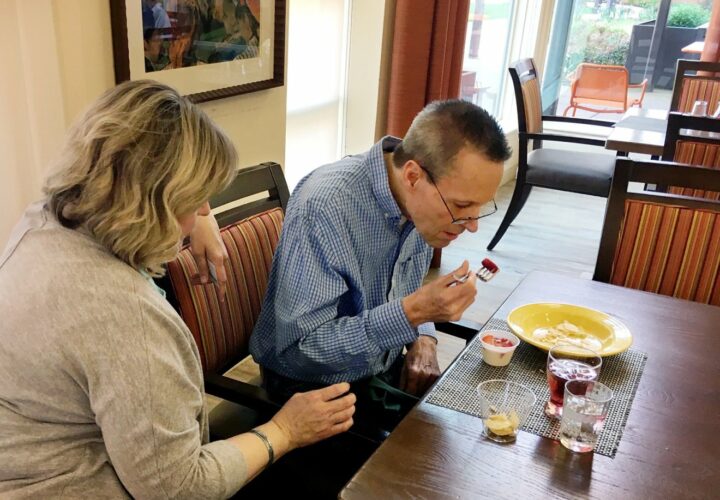Swallowing issues can be a slippery slope to a number of other problems. Speech, language, eating and swallowing experts shares ways caregivers can identify, manage and treat swallowing-related conditions (dysphagia).
As many as half of people living with Alzheimer’s may lose the ability to feed themselves as the disease progresses. Declining motor, sensory and cognitive skills may lead to trouble eating, or to difficulty swallowing, due to any of a number of swallowing-related conditions called dysphagia. Trouble swallowing can in turn lead to more serious health issues, from dehydration and malnutrition to pneumonia.
Rinki Varindani Desai, a speech-language pathologist at the University of Mississippi Medical Center, said caregivers of people living with dementia should consult with a doctor as well as a speech-language pathologist on the best and safest ways to manage dysphagia, nutrition and hydration options, keeping in mind the person’s advance directives and wishes.
“Caring for a person with dysphagia and dementia presents a set of unique and difficult challenges,” Desai wrote in an article for the National Foundation of Swallowing Disorders. “With the right training, knowledge, and support, caregivers can enhance the quality of life of their loved ones with dementia. Regardless of a diagnosis, every individual deserves to ‘dine with dignity.’”
Being Patient spoke to two speech-language pathologists about treatments and strategies for caregivers that may help manage and treat dysphagia.
1. Pay attention to posture.
Posture can be a major player when it comes to safety and swallowing. Caregivers should ensure that their loved ones with dementia and dysphagia are in a comfortable and upright position during meals, Desai wrote, and keeping them upright for 30 minutes after eating can help with digestion.
Meanwhile, a speech-language pathologist may recommend adjustments to a patient’s postures. According to Nicole Rogus-Pulia, a speech-language pathologist and an assistant professor of medicine at the University of Wisconsin-Madison, one adjustment includes the chin tuck, which moves the base of tongue further back to the throat and narrows the entrance to the airway to reduce the risk of aspiration. Another is the head rotation, which involves turning the head to the side while swallowing. It can be helpful for people with weakness on one side of the throat, redirecting material to the stronger side.
“With the right training, knowledge, and support,
caregivers can enhance the quality of life of
their loved ones with dementia. Regardless of a diagnosis,
every individual deserves to ‘dine with dignity.’”
“It really depends on the patient whether or not these postures are effective,” Rogus-Pulia told Being Patient. “For some patients, it can actually have the opposite effect where it causes more material to go down the wrong way.”
Some people conduct these postural adjustments without consulting a speech-language pathologist, and she urges people to see a one before attempting these postural adjustments on their own.
2. Cut down on distractions at meal time.
Eating safely requires focus — even for people in peak cognitive and physical health. For older adults grappling with dementia’s impacts on cognitive, motor and sensory skills, it’s all the more important.
To reduce distractions, Rogus-Pulia said, limiting the number of people eating with the patient can help while ensuring that dining remains a social event.
“We use the same mechanism in our throat to breathe, cough, swallow [and talk],” Rogus-Pulia said. “If we’re trying to do too many things at once and we’re not paying close attention, the precise coordination that says ‘it’s now time to stop breathing, and swallow’ can be disrupted.”
Serving meals in a quiet environment, Desai added, using basic utensils required for a meal and avoiding placing unnecessary items on the table that can be distracting or confusing can also help.
Rogus-Pulia noted that caregivers should encourage loved ones to feed themselves, helping to the extent necessary so they can remain independent while dining. One approach that is effective is known as the hand-under-hand technique, where caregivers place their hands under the hand of the person they are looking after to help guide the hand to their mouths.
3. Encourage slower, smaller bites.
Caregivers should encourage their loved ones to eat slowly as people with dementia may require longer to complete their meals, Desai said. Smaller, more frequent meals or snacks throughout the day may help.
To ensure swallowing safety, she reminded caregivers to ensure that all food and liquid are swallowed before feeding the next bite. Frequently checking their mouths to make sure there is no accumulation of food is also important. And maintaining oral hygiene is crucial as it is one of the leading risk factors of aspiration pneumonia for those with dysphagia.
4. Use visual and verbal cues.
Selecting dish ware that makes it easy to see the food because of its color or lack of patterns is another helpful way to guide a person through a safe meal.
Desai added that verbal prompts can help, too: “Depending on the person’s language ability, this may mean giving very specific directions such as ‘open your mouth’, ‘chew’, ‘swallow,’ offering simple choices such as ‘Do you want soup or a sandwich?,’ or asking simple yes/no questions rather than open-ended ones.”
5. Modify the diet.
Making food easier to see may not be quite a big enough change. Changing the food altogether, so that it is easier to manage, could be needed. Desai writes:
“For some people with dysphagia, the texture of a ‘normal’ diet can simply present too many risks, in which case, specific recommendations may be given by the [speech-language pathologist] about making changes to the texture or consistency of food/liquids, to reduce the risk of choking and other dysphagia-related complications … Though it will sometimes be necessary to make these changes to food texture or to thicken liquids, it is important to still try to maintain the look of a normal diet, as this can preserve your loved one’s enjoyment of food and help people with perceptual or memory difficulties recognize what they are eating.”
6. Consult with a speech-language pathologist about tube-feeding and other feeding options.
A feeding tube is a medical device designed to provides nutrition to people who cannot eat or swallow safely, or who need supplemental nutrition. For caregivers to people in advanced stages of dementia, it’s a complex decision. Some physicians may recommend tube feeding when people’s dementia progresses to advanced stages and dysphagia becomes severe. However, studies have shown that the tube-feeding does not improve the quality of life for people with advanced dementia nor prolong duration of life.
According to Desai, tube-feeding may also increase a patient’s risk for additional health problems. “In advanced stages, we have overwhelming evidence to show that it’s not going to prevent aspiration pneumonia,” she said. “It’s not going to prolong their survival rate. And it’s actually another source of infection when you have a feeding tube in the stomach. The burden of having it doesn’t outweigh the benefits.”
Rogus-Pulia added: “Sometimes, a speech-language pathologist isn’t included in the end-of-life feeding discussion. And we really should be, because there’s so much we can do to recommend safe swallowing that also aligns with the patient and [their family’s] goals of care. There are ways that we can modify what you’re swallowing that still are enjoyable.” She said it is critical for people with a dementia diagnosis and their caregivers to discuss feeding options with their clinicians early, to make an informed decision.
However, both experts noted that tube feeding can help if patients with swallowing problems are admitted to the hospital temporarily due to acute illnesses or choking incidents. According to Desai, patients should work with a speech-language pathologist for rehabilitation.
7. Consider rehabilitative therapies for dysphagia.
Some studies have found that certain tongue-strengthening exercises and other rehabilitative therapies for dysphagia have shown promise in helping people improve sensory function, chewing abilities, and their safety and efficiency in swallowing.
But according to Rogus-Pulia, there is still a dearth of research on effective therapies for swallowing for those living with dementia: “Traditionally, it’s just been expected that individuals who have cognitive impairment can’t participate in more of a rehabilitative approach,” she said. “We know from other studies focused on individuals with Alzheimer’s disease and other dementias that certainly they can participate in rehabilitative interventions.”
“General exercise has been shown to be really effective and lots of studies [show it can reduce] fall risk,” she added. “We really need to think about how we can apply that same type of intervention to swallowing.”
Rogus-Pulia and colleagues are currently conducting a clinical trial to study the effectiveness of two interventions. One includes placing a small pressure bulb on the tongue which patients can push against the roof of their mouths repeatedly. With the device, clinicians can examine the pressure exerted by the patient and create targets for patients to work toward. Another intervention is a saliva substitute gel, which may increase lubrication in the mouth, reduce the effort needed while swallowing, and potentially improve oral health.
She hopes that such interventions may help slow down the decline of people’s swallowing abilities and build their muscle reserves, thus staving off the potential impacts of dysphagia for as long as possible and improving their quality of life.
Contact Nicholas Chan at nicholas@beingpatient.com




